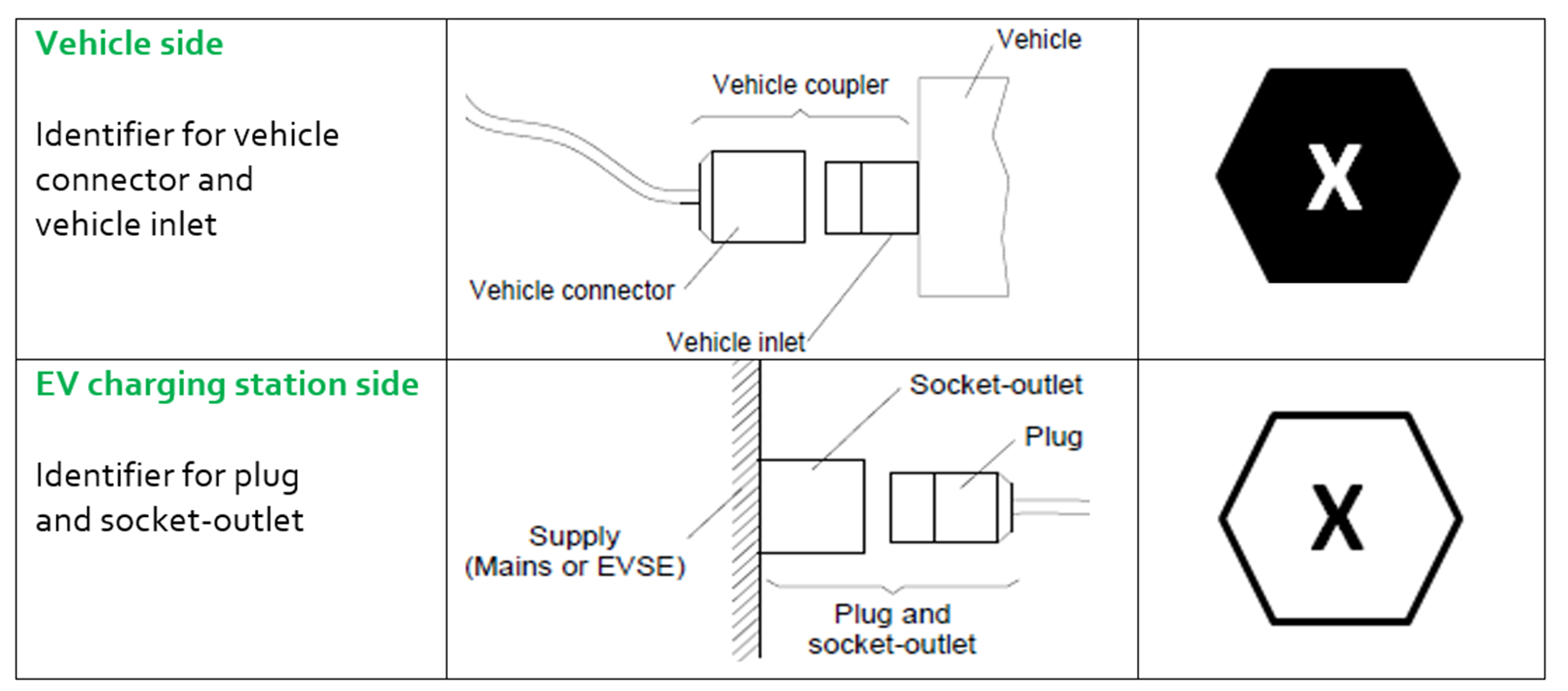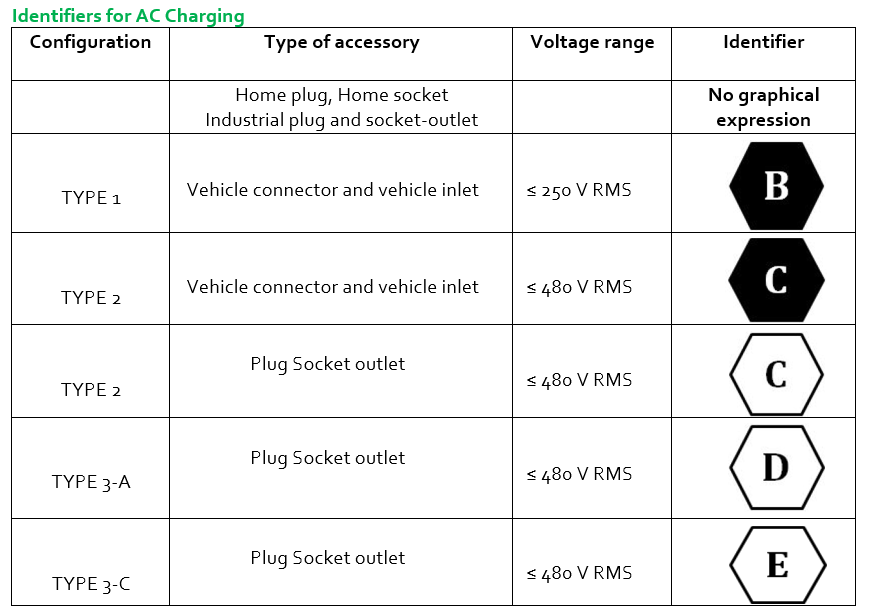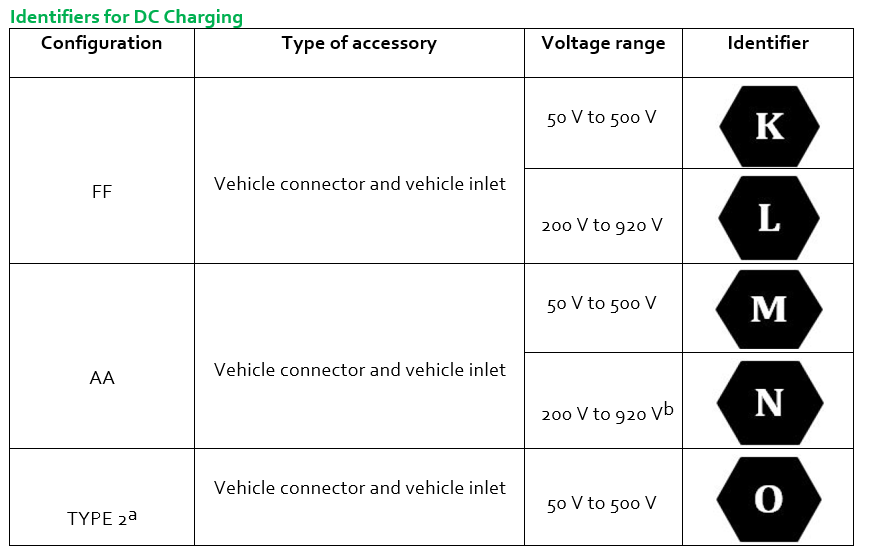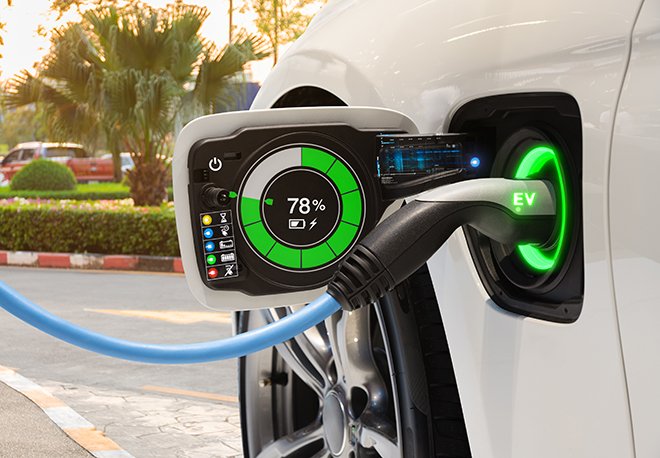LABELLING FOR ELECTRICALLY RECHARGEABLE ROAD VEHICLES AND CHARGING INFRASTRUCTURE
INFORMATION FOR CONSUMERS
GENERAL INFORMATION
In order to help consumers understand the new EV labels appearing on new vehicles and what that means for charging, the European Union has agreed new labelling requirements for newly produced vehicles and charging stations. As of 20 March 2021, a new harmonised set of labels to help identify compatible recharging options for electric road vehicles will appear across Europe.
These labels will be placed:
- On newly-produced vehicles near each vehicle charging location and on each charging plug.
- On detached charging cables.
- In the vehicle owner’s manual or in the electronic handbook.
- On EV charging stations adjacent to the socket-outlet or to the storage location of the vehicle connector cable, and
- For information, in vehicle
I AM TRAVELLING ABROAD. WILL I FIND THE LABELS IN THE CHARGING STATIONS OF THE COUNTRIES I DRIVE THROUGH?
The new labels will be deployed in all 27 European Union member states, EEA countries (Iceland, Lichtenstein and Norway), and also Macedonia, Serbia, Switzerland and Turkey.
WHAT ABOUT THE UK AFTER BREXIT?
It is up to the UK to decide the way in which EU rules will apply after Brexit, but newly produced vehicles will have the labels fitted on the production line so vehicles entering the UK market will have the labels.
WHICH VEHICLES ARE CONCERNED BY THIS LABELLING REQUIREMENT?
When it comes to road vehicles, the labels will appear on newly produced electrically rechargeable vehicles in the following categories:
- Mopeds, motorcycles, tricycles and quadricycles;
- Passenger cars;
- Light commercial vehicles;
- Heavy-duty commercial vehicles;
- Buses and coaches
ARE VEHICLES OF ALL AGES CONCERNED?
No. The European legislation requires the labels only for the new vehicles placed on the market for the first time or registered as of 20 March 2021. Vehicle manufacturers do not recommend fitting the labels to any older vehicles.
WHEN WILL THESE LABELS BE VISIBLE IN EU MEMBER STATES?
As of 20 March 2021, the label will be placed on all newly produced electrically rechargeable vehicles (i.e. battery electric and plug-in hybrid-electric vehicles) and on all European Union charging stations in a clear and visible manner for consumers. Since this is a compliance date, vehicle manufacturers and charging stations operators will start to introduce these labels over a transitional period prior to that date.
HOW DO THESE LABELS WORK?
The label is simply a visual tool to help consumers verify that they correctly select an appropriate charging option for their vehicle. Consumers will only need to match the label of their vehicle with the corresponding label on the charging station.
DESCRIPTION WITH PHOTOS FOR DIFFERENT LABELS-
The shape for all electrical interfaces is a regular and horizontal hexagon. The electrical interface is categorized by a symbol. The symbol consists of a single letter in normal Latin script.

ANNEX1


LABELLING FOR ELECTRICALLY RECHARGEABLE ROAD VEHICLES AND CHARGING INFRASTRUCTURE
INFORMATION FOR CHARGE POINT OPERATORS
GENERAL BACKGROUND
European Union (EU) Directive 2014/94/EU of the European Parliament and of the Council (the ‘co-legislators’) addresses the EU-wide deployment of alternative fuel infrastructure. This Directive addresses Europe’s future needs for providing wider access to ‘alternative fuels’ and includes a requirement for new vehicles and all fuel pumps/recharging stations to be labelled in order to enable vehicle drivers to better select the fuel or recharging option that their vehicle can properly use. The Directive provides for the deployment of a new unique and harmonised set of fuel and electric charging labels.
For the electric vehicles these labels will appear:
- On newly-produced vehicles near each vehicle charging location and on each charging plug.
- On detached charging cables.
- In the vehicle owner’s manual or in the electronic handbook.
- On EV charging stations adjacent to the socket-outlet or to the storage location of the vehicle connector cable, and
- For information, in vehicle dealerships
WHO DEVELOPED THE NEW LABELS
A specific task force under the CEN (European Committee for Standardisation) Technical Committee 301 (TC 301) worked on the design and format of the new labels to comply with the general prescriptions of Directive 2014/94/EU. The participants of the task force included experts from the electric vehicles and charging stations industry, NGOs representing consumers, national standard bodies, a number of EU governments and the European Commission. Standard EN 17186 describes the technical design and size of the new labels.
WHICH VEHICLES ARE CONCERNED BY THIS LABELLING REQUIREMENT?
When it comes to road vehicles, the labels will appear on newly produced electrically rechargeable vehicles in the following categories:
- Mopeds, motorcycles, tricycles and quadricycles;
- Passenger cars;
- Light commercial vehicles;
- Heavy-duty commercial vehicles;
- Buses and coaches
ARE VEHICLES OF ALL AGES CONCERNED?
No. The European legislation requires the labels only for the new vehicles placed on the market for the first time or registered as of 20 March 2021. Vehicle manufacturers do not recommend fitting the labels to any older vehicles.
WHEN WILL THESE LABELS BE VISIBLE IN EU MEMBER STATES?
As of 20 March 2021, the label will be placed on all newly produced electrically rechargeable vehicles (i.e. battery electric and plug-in hybrid-electric vehicles) and on all European Union charging stations in a clear and visible manner for consumers. Since this is a compliance date, vehicle manufacturers and charging stations operators will start to introduce these labels over a transitional period prior to that date.
WHERE TO FIND THESE LABELS ON VEHICLES?
The labels are visible on newly produced vehicles near each vehicle inlet and on each plug, as well as on the detached charging cables. Information on the labels will also be found in the vehicle owner’s manual or in the electronic handbook.
WHEN WILL THESE LABELS BE VISIBLE IN EU MEMBER STATES?
As of 20 March 2021, the label will be placed on all newly produced electrically rechargeable vehicles (i.e. battery electric and plug-in hybrid-electric vehicles) and on all European Union charging stations in a clear and visible manner for consumers.
Since this is a compliance date, vehicle manufacturers and charging station operators will start to introduce these labels over a transitional period prior to that date. The labelling of charging stations is also submitted to the specific national laws implementing the European Directive.
WHAT ABOUT THE UK AFTER BREXIT?
It is up to the UK to decide the way in which EU rules will apply after Brexit, but newly produced vehicles will have the labels fitted on the production line so vehicles entering the UK market will have the labels.
WHERE TO FIND THE LABELS AT THE CHARGING STATIONS?
Labels shall be affixed to an EV charging station adjacent to socket-outlet(s) or to the storage location(s) of vehicle connector (s); on the vehicle connector of each cable assembly or on a flag attached to each cable in the immediate proximity of the vehicle connector, or on floating cables if any. In case of a payment or selection terminal that is separate from the EV charging station, it shall be affixed near or as part of the selection device.
Additional information may be included on the label at charging points, according to national requirements and in the local language.
WHAT DO THE LABELS LOOK LIKE?
The labels display the information regarding the station/vehicle compatibility so that a consumer can easily identify the electrical interface that their vehicle can use.
The size of the identifier shall be a minimum of 30 mm in diameter (width), with an outer line thickness of at least 3,2 points, for placement on the EV charging station adjacent to the socket outlet and in the vehicle dealership.
The shape for all electrical interfaces is a regular horizontal hexagon. The electrical interface is categorized by a symbol. The symbol consists of a single letter in normal Latin script. The font size of the symbol shall be scalable to the size of the shape, but the minimum being 32 points for 30mm diameter.
WHAT IS THE ACTUAL MEANING OF THE LABEL?



FAQ
- What label requires a Combined Charging System if the charger can cover the upper voltage ranges of both label “K” and “L” (example: a charger that covers voltages from 200 to 920V)?
Any charging station not able to cover a voltage above 500V should receive only the label ”K”, with the additional comment in Field D ”200V-500V” to indicate the lower limit of the Voltage range.
- Are digital labels required by the Standard?
The Standard makes reference only to physical representations of the symbols. Digital representations (mobile application) are not required by the Standard. Additional display of the labels on digital screens or signposts is optional/voluntary.
- How many labels should be applied on a charging station with several charging points?
Each charging point need its own label according to its voltage range.




